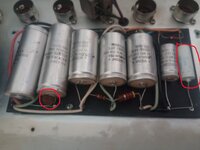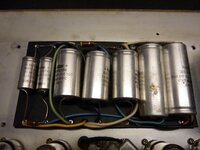_brian_
Member
Hi all,
I'm trying to restore my twin reverb back to health, I love the amplifier but I've never gotten round to giving it the TLC it deserves. However, there seems to be a discrepancy in capacitor sizes and online schematics and I'm not sure how to continue.
This amp was gifted to me by my uncle a long long time ago, he purchased it from a shop for £50! The low price was due to it not working but all it needed was a new tube, he then gigged with it constantly and when he retired around 15 years ago gave it to me.
It goes without saying that I don't want to change anything to the detriment of the amplifier's sound, but I have noticed it does need some work.
One of the electrolytic capacitors has a large leak, another has the beginnings of a leak, and there seems to be a non-original capacitor soldered in there which I don't know the value of because the text has rubbed off of it.
The capacitors are as follows;
220 MF, 285VDC
220 MF, 285VDC
20 MF, 500VDC
20 MF, 500VDC
20 MF, 500VDC
70 MF, 70VDC
>Unknown Capacitor<
Apart from the unknown capacitor, the rest look to be original Mallory's. I'm an engineer, and have some electronic understanding but not a lot regarding audio equipment. I tend to like to write music more than fixing the things that make it! However this amp was a present and I want to be careful with it.
Can anyone advise me of what the likely value is for this unknown capacitor and perhaps advise me on which electrolytic caps to replace them with?
Would it be best just to replace all the capacitors or just the ones that test or look bad?
Many thanks for your help.
I'm trying to restore my twin reverb back to health, I love the amplifier but I've never gotten round to giving it the TLC it deserves. However, there seems to be a discrepancy in capacitor sizes and online schematics and I'm not sure how to continue.
This amp was gifted to me by my uncle a long long time ago, he purchased it from a shop for £50! The low price was due to it not working but all it needed was a new tube, he then gigged with it constantly and when he retired around 15 years ago gave it to me.
It goes without saying that I don't want to change anything to the detriment of the amplifier's sound, but I have noticed it does need some work.
One of the electrolytic capacitors has a large leak, another has the beginnings of a leak, and there seems to be a non-original capacitor soldered in there which I don't know the value of because the text has rubbed off of it.
The capacitors are as follows;
220 MF, 285VDC
220 MF, 285VDC
20 MF, 500VDC
20 MF, 500VDC
20 MF, 500VDC
70 MF, 70VDC
>Unknown Capacitor<
Apart from the unknown capacitor, the rest look to be original Mallory's. I'm an engineer, and have some electronic understanding but not a lot regarding audio equipment. I tend to like to write music more than fixing the things that make it! However this amp was a present and I want to be careful with it.
Can anyone advise me of what the likely value is for this unknown capacitor and perhaps advise me on which electrolytic caps to replace them with?
Would it be best just to replace all the capacitors or just the ones that test or look bad?
Many thanks for your help.


